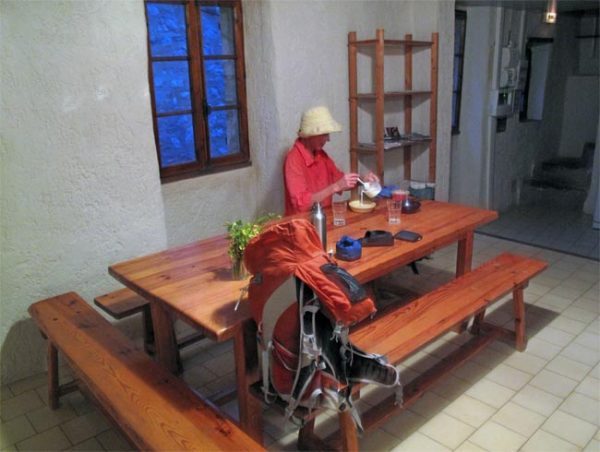
Sunday, 8 July 2012
Distance 38 km
Duration 9 hours 50 minutes
Ascent 1279 m, descent 1233 m
Map 170 of the TOP100 lime-green series
Before dawn we were both awake, worried about the day to come. It was a long, hard stage and there was no way to shorten it, and no hope of coffee until St-Jean-de-la-Blaquière, five or six hours away. But even if we had been at peace, the bells would have woken us every hour of the night.
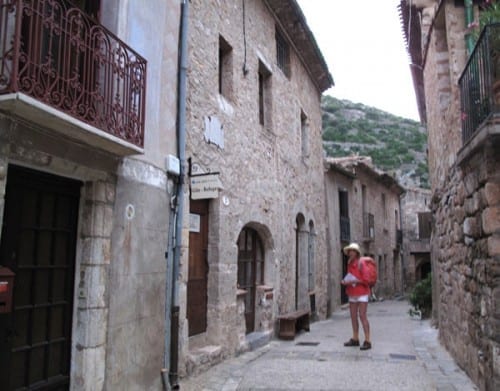
We got up at 5:30, just in time to say goodbye to the other walker (whom we never saw again), then gulped down some muesli, packed hastily and left at 6:10 am.
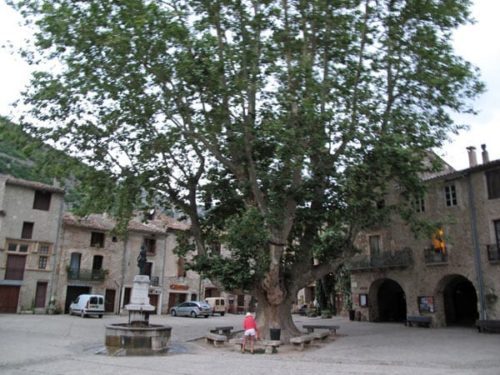
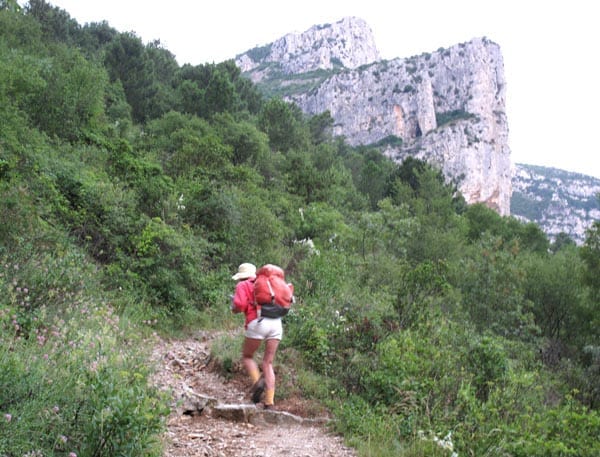
The Place de la Liberté, which had been seething with tourists last night, was deathly quiet now. The great tree reigned alone over a scene that would have been the same, except for a few cars, when it was a sapling.
We hurried off along the lane and quickly left the houses behind, following the stream, with tall bluffs rising on both sides. To my surprise, there was a beautiful vegetable patch on a strip of flat land beside the water.
We were overtaken by a strange gangly figure wielding two walking poles. He wore tight, striped leggings, running shoes and a tiny pack, and told us, with an intense stare, that he was going north on the GR74, to Navacelles. Last seen he was almost running up the path towards a col.
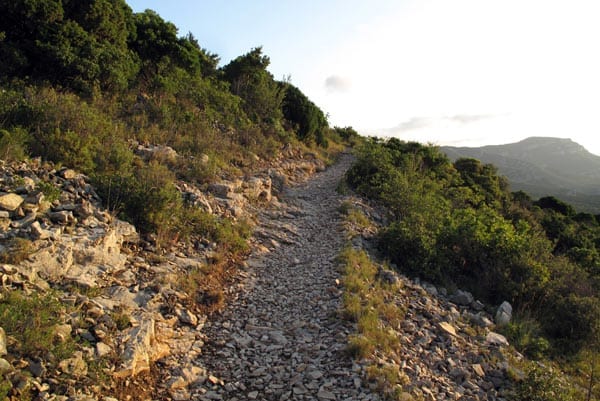
Our track continued along the stream and crossed a footbridge, where the serious climbing began.
We estimated that there were fifty zig-zags before we reached the ridge, but the track was well-made and well-signposted, somehow managing to weave its way up through seemingly impassable walls of rock.
The surrounding vegetation was surprisingly dense, considering how dry and stony the track was.
At every turn, the view opened out more and after an hour and a half we came to the top, with another view over the open land to the south. That was the end of the climbing for a while.
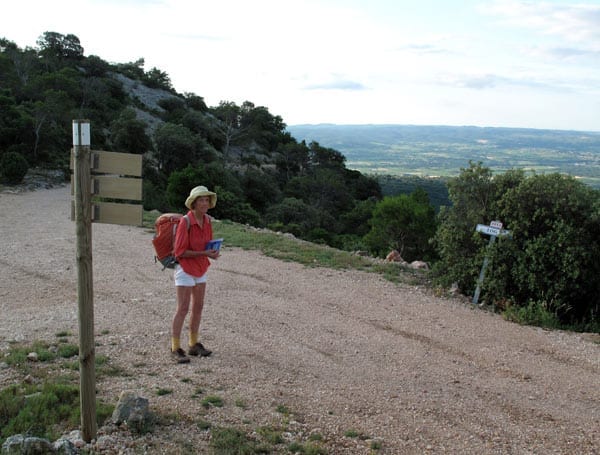
There was a dirt road along the ridge, which was easy going and very pretty, winding among the trees with grass and flowers between drifts of white pebbles. The GR marks guided us past a couple of crossroads towards the south.
By this time we were out of the charming groves of the summit and more exposed to the sun, so we stopped briefly beside the track to put on sun-screen.
While we were at it, we had a little refreshment, made up of bread from Montpellier with a morsel of steak from Montarnaud.

The only reason that we were still carrying these stale scraps was that we had not had lunch for the past two days, being too tired and too late arriving to bother.
We started to descend, partly on dirt roads and partly on tracks, although the route did not seem to agree with what was on our map.
Nevertheless we persevered and at last saw below us the large village of Montpeyroux. The GR seemed to be heading there and we felt that it could not fail to provide us with second breakfast.
As the track plunged toward the valley, we saw a long crenellated curtain wall stretching its arms across the slope below, and eventually we reached it.
This was the fort of le Castellas, built about the year 1000 by a descendant of St-Guilhem, and reduced to ruins by the successive misfortunes of the Hundred Years War and the Wars of Religion.
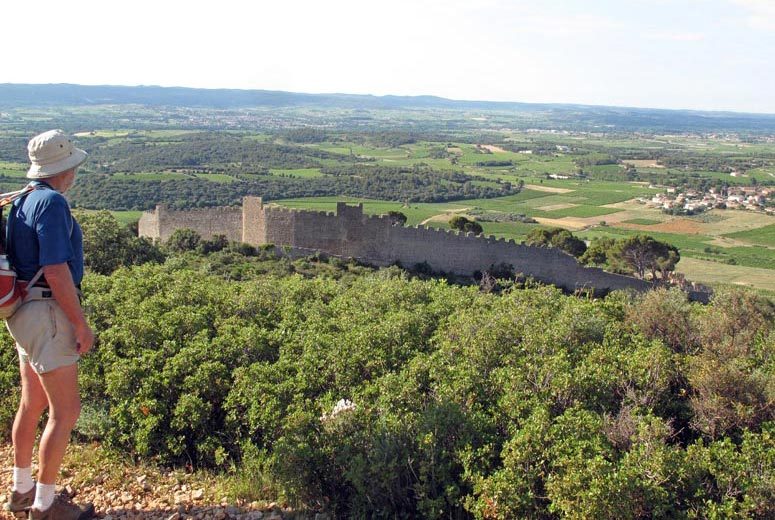
From there to the valley the GR was a vehicle track, and also a botanical trail, with panels of information about the plants along the way.
At the tiny hamlet of le Barry, the GR turned right, but we could almost smell the coffee at Montpeyroux and kept going straight ahead on the bitumen.
Entering the village, we passed a closed bar which opened at 10 o’clock (it was about 9:30), so we pressed on to the main square, wide and handsome, with the slender church tower at one side.

There were shops of various sorts and people bustling about, but no bar. We could hardly believe it. A man pointed us vaguely along the street and we walked the length of it to no avail. At least it was in the right direction to get us back on the GR.
Deeply despondent, we trudged on across the fields until the GR came in from the right and we parted company with the road, just in time to avoid a new, circuitous, high-level concrete bridge leading into Arboras.
Instead we went down and crossed the stream on the old stone bridge, now closed to cars. It was much lower than the new one, but still as high as a seven-story building.
The small village of Arboras clung to the slope above the stream and the GR climbed towards it. We already knew, from the Topoguide, that there were no amenities in the village, so we were amazed to see a hand-written sign on a post – “Café Atelier” with an arrow pointing ahead. As we reached the main street there was another sign and we saw tables and chairs on a raised terrace under a tree.
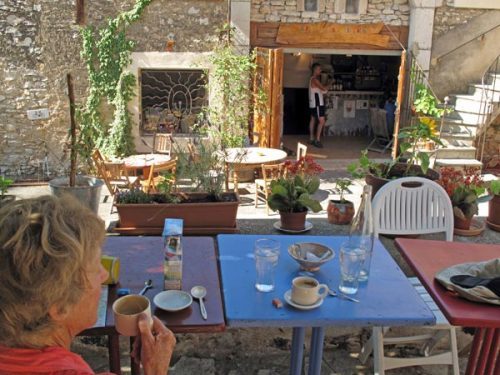
The actual café was across the road in the pottery, with its big wooden doors flung open welcomingly, a delightful surprise after the disappointment of Montpeyroux.
We ordered grand’ crèmes but our hostess had no milk so we got large black coffees and added powdered milk from our supplies, making a thick, hot, reviving brew. With the coffee we had large glasses of water crammed with ice.
We were not the only people to appreciate this service. Two groups on motorbikes stopped for cold drinks in the shade, and some cyclists used the water spout outside the café to drench themselves.
As we paid, we told our charming long-haired hostess (the potter) that her café was not listed in the Topoguide. Little wonder, she replied, I’ve only been open two months.
Setting off again with our bottles full of icy water, we dropped down to the valley and followed a farm road pleasantly through the vines, feeling fresh and optimistic. Ahead we could see a village, which we fondly imagined was St-Jean-de-la-Blaquière, our next destination.
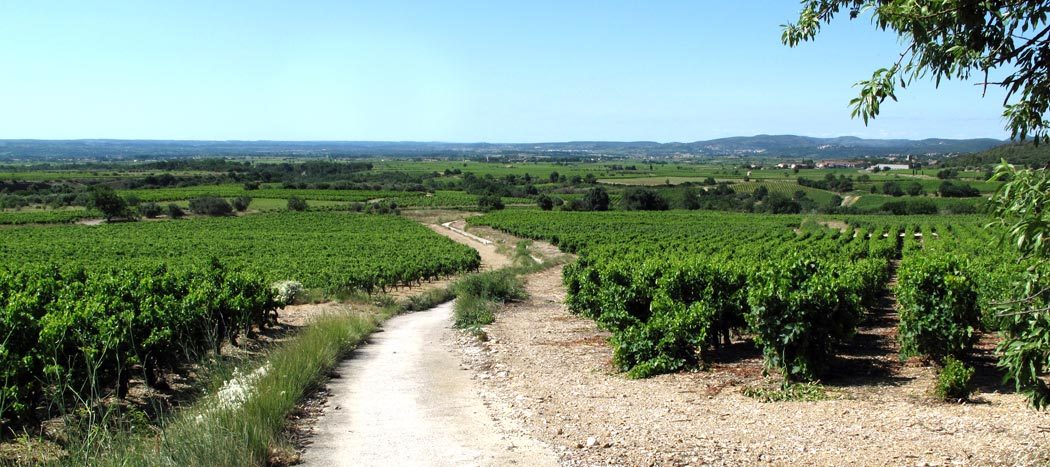
The farm track merged into a small patched road and curved around over the river, which was choked with greenery. A bit further on, the GR signs pointed us off to the right, in the opposite direction to the distant village. This seemed entirely wrong until we checked our compass and discovered that in fact we were going north-west, as we should have been, and that the village we had seen in the distance was actually not St-Jean-de-la-Blaquière, but St-Saturnin-de-Lucian.

The gravel road that we were on rose steadily up the flank of the valley and we were soon on a level with Arboras again, although separated by the deeply-cut river.
After a while we turned away from the river valley and ascended even higher. We were relying completely on the GR signs for directions, as there were occasional forks and switchbacks in the road. Luckily the way was well marked at every corner and we swung along confidently.
Then, at the foot of a long downhill section, we came to a place where the road divided and there were no GR signs to be seen, even though we searched assiduously. At last we decided that we would have to go back until we found a GR sign, and we went more than a kilometre up the road before we found one.
It turned out that the GR had turned off the main dirt road, onto a steep, narrow goat-track, and we had failed to notice the turning sign and then missed not one, not two, but three “go back” cross signs. They were very obvious the second time. This little misadventure added a couple of kilometres to the day, but there was nothing to be done about it except push on.
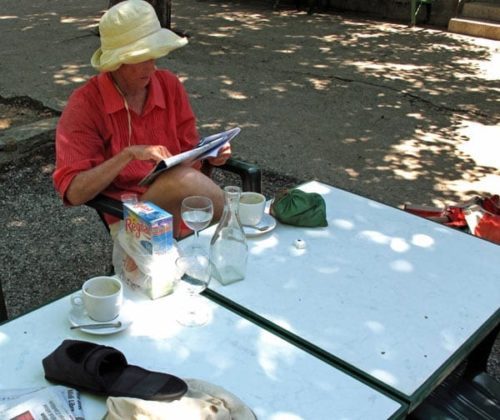
At the top of the goat-track was a lone tree, and here we joined a different dirt road which rose for a while and then stopped. After that it was a rough track again, through thick forest with no visibility beyond the nearest bushes. Most of the time we were clambering down over rocks and tree-roots.
Finally we came out of this enclosed world onto a road and soon afterwards entered St-Jean-de-la-Blaquière. It was nearly 2 pm and the village was deep in Sunday afternoon torpor.
We asked a couple of lounging locals about a bar and they pointed us up the street to the square, where the restaurant was still open, although the diners had gone and the waitress was washing up. Under the generous shade of a plane tree, we had another round of coffee, accompanied by copious amounts of water, and also refilled our water bottles.
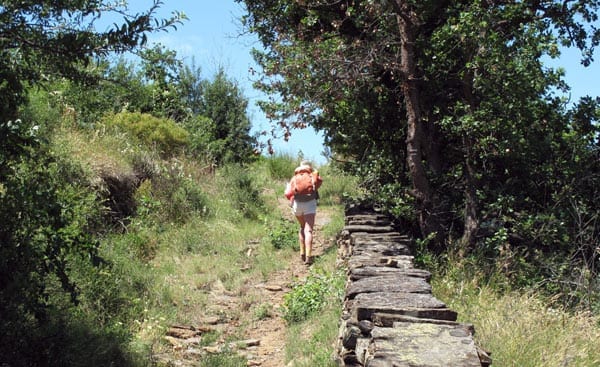
By now the heat of the day was becoming oppressive and we were uncomfortably aware that we had a good three hours of walking ahead of us, so we did not linger.
The GR went along a back street and then into the meadows on a lane. We crossed the stream and struggled up a track beside a broad stone wall, which led us into Usclas du Bosc, a fortified hamlet with a great deal of charm and little else.
The single street went up past a statue of the Virgin and became a dusty path which continued climbing away from the houses and into a dry oak forest.

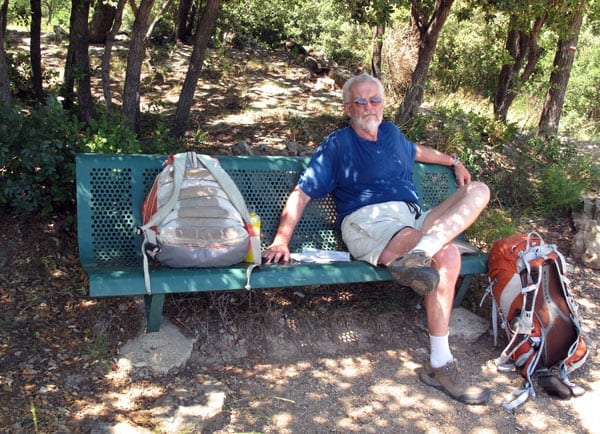
The gradient increased and still we climbed, eventually reaching a metal bench set beside the track. With great relief we threw off our packs and sat down, convinced that the seat marked the top of the ascent.
It did not. There was a further soul-destroying uphill section on what appeared to be shattered concrete, after which we entered a pine forest.
A large notice announced a change in the alignment of the GR but gave no details, so we kept following the marks up between the rows of pines. At least it was shady there, and we were hot and tired.

At the brow of the hill we met a couple in sandals picking their way daintily along and we took this as a sign that the road (the D153) was nearby. A short time later we saw their car below us, and stepped out onto the tar at about 3:45 pm.
The time was important, because we had arranged to meet some friends at the cathedral in Lodève at 6 pm, not realising what a long day it would be.
We were eight kilometres by road from Lodève and it was obvious that the quickest way to get there was straight down the bitumen rather than on the GR. Even so it would be a close-run thing. We put our heads down and set off at speed.
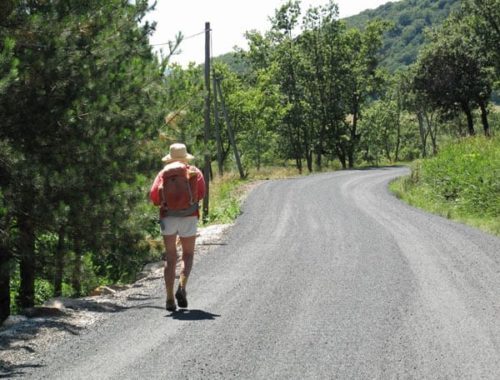
It was a beautiful road through the forest with a constant descent and very little traffic. To keep our minds off our straining legs, we timed each kilometre – at first it was eleven minutes, but later twelve or even longer as our energy waned. Sometimes through the trees we could see the pale pink town in the valley below, backed by its enormous buttressed cathedral.
The only people we met were a family group having a picnic beside their car, who assured us that it was no distance to Lodève (only six kilometres), and another family riding bikes up the road.
The small son managed to overbalance into the ditch just as we walked past, so I hoisted him, bike and all, back onto the road and strode on without missing a beat.

At last we came to the outskirts of the town, passed under the autoroute (which had been under construction last time we visited Lodève in 2004) and onto the N-road beside the river.
Soon we arrived at the hotel that we had stayed in before, la Croix Blanche.
At the desk was the same grim housekeeper, efficient and unsmiling in her dust-coat, and she showed us to our room behind the main hotel, looking out onto the enclosed garden.
Then she relented slightly and pointed out the clothes lines hanging in the laundry opposite.
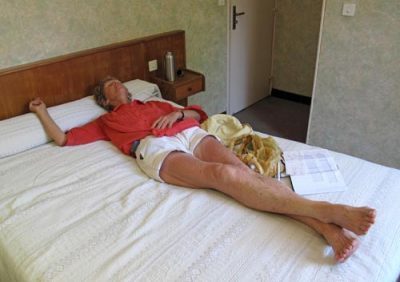
It was 5:15 pm. For the first twenty minutes we lay comatose, too exhausted to move, then we roused ourselves enough to have showers, put on clean clothes and wash our worn ones.
We hurried across the bridge and into the old quarter, arriving at the door of the cathedral at five past six. Not a bad effort for one day.
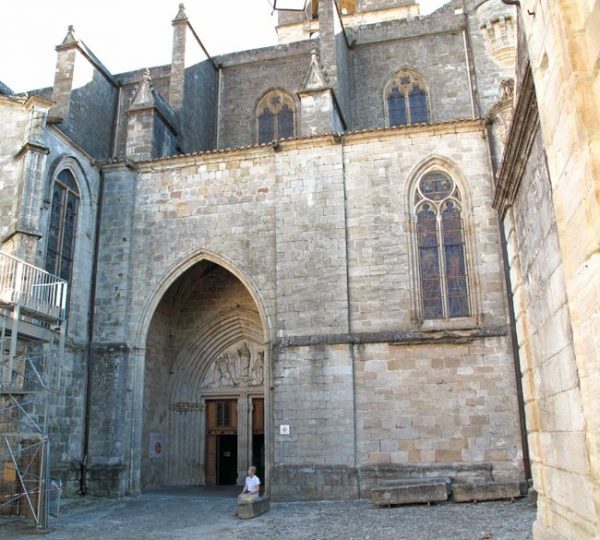
Our friends were fifteen minutes later than us, as they had been watching le Tour on the TV and had forgotten the time.
We had drinks in the square near the cathedral and then ate at the Logis de France hotel just across the bridge from our hotel. There was a courtyard at the back, beside a swimming pool, where guests were dining.
The formula was two courses for €20 or three for €25, and among the six of us, we covered most of the menu.
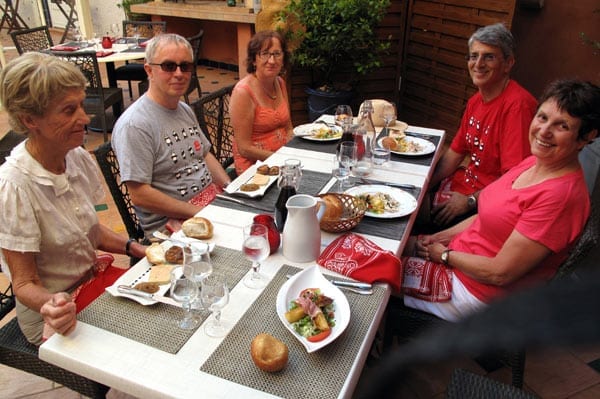
We had carpaccio of duck, paté de foie gras and nems (sort of French spring rolls) as entrées, then lamb, entrecôte and duck for our main courses.
For dessert we had lemon tart, chestnut cake and rum baba (which came with a bottle of rum to splash on top).
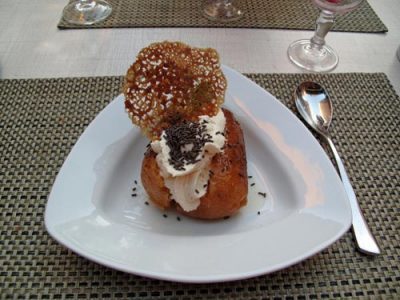
Altogether it was a splendid finish to a long, strenuous day.
Previous day: Montarnaud to St-Guilhem-le-Désert